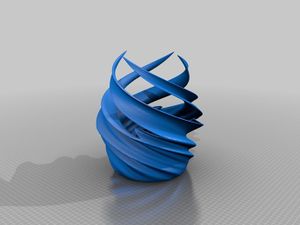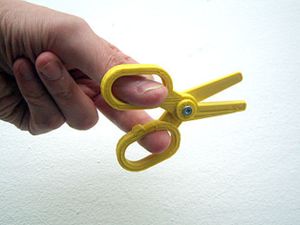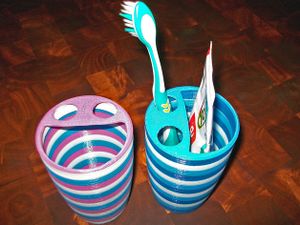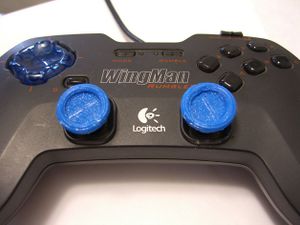User:EvaVivu/Blog
Main | About Me | Class Blog
For this class we write weekly blogs on a variety of topics that have to do with 3D printing.
Contents
Blog 1: Thingiverse
We had to explore around on Thingiverse and find different items.
An item that is amazing/beautiful
Here is a beautiful vase with a vortex swirl theme to form it. I really liked this piece since it seems to be very smoothly designed. Source
An item that is funny or strange
I must admit I was having trouble finding something for this category. So I started typing in random words. One of them happened to be teeth and I saw this! I know what my pumpkin is going to look like next year! Source
An item that is useless
These scissors will definitely not cut through any paper. Even toddler scissors can at least cut a little. The idea is cute though. Source
An item that is useful
I thought this item was cool. It's kinda neat how the cup separates your toothbrush from your tooth paste, and it smiles at you! It would be something I would use at home. There are plenty of other useful things on thingiverse though. Source
Something which surprised you...
None of the things I found really surprised me. I have used thingiverse before so I am quite familiar with the site. It is always fun to find new things, so I decided to use another useful printed object. A video game controller joystick. It happens that joysticks can get over used and then don't run as smoothly, so a quick fix is to 3D print one! Source
Blog 2: Open Source Ecology
Open Source Ecology[1] is a site that offers anyone to take ideas and build technologies in an easy and economical way. Let me explain further. Marcin Jakubowski, a farmer who loved to construct, started this because of the expense of buying technologies. He wanted to build a tractor by himself that he would be able to repair. He also wanted to share this information with fellow people that were having the same economical problem. This is where open source ecology program started. It has grown exponentially since then and has become a global site. Even other cultures and spoken languages have worked their way into this site, as you can see in this video[2].
I think it is a wonderful idea and truly ingenious towards engineers that are eager to build things and solve problems but don't have the money (or the job) to do so, people who need some form of technology, and all others who just like to share their ideas. It is definitively an organized site that makes sure everything runs right with different people in charge[3]. I am sure if more people knew about this site they would use it more often. That is why I encourage anyone reading this blog to take a look at this site, it is truly fascinating.
An article was written about open source ecology and Marcin Jakubowski on the new yorker magazine[4]. I was going to talk more about this article and how it seems to somewhat worship the open source ecology project. But funny enough, the article in its entirety cannot be accessed through the new yorker magazine website without a paid subscription. I am sure there are other ways of finding this article, but is it truly worth searching all over the web? Maybe the new yorker can learn from Open Source Ecology in the 'Open' part of it. But, to be fair, they need to make money to pay for their writers somewhere.
If there was a similar project to this one a professor that would be interested is Dr. Scholtz from the Penn State Lehigh Valley campus. He is always looking to expand his knowledge and has even let student experiment and learn with the 3D printer at the Lehigh Valley campus. Now if I had to choose what my team would be I would like them to be international and willing to broaden their horizons, "think outside the box".
Blog 3: Article discussion
We had to read an articleand answer the following questionsSource
Who created this design and when/where was it done?
The original design actually started by a woodworker, Richard Van As, in South Africa. He had lost some of his fingers in a wood shop incident and started designing a 'mechanical helping hand'. The woodworker found help to design this Robohand from Owen, a theatrical artist who makes mechanical limbs for puppets. With the two of them together they were able to make a Robohand prototype in November 2012.
If you wanted to make one, where would you get it?
Thingiverse of course! The technology has grown much since the Robohand was posted on thingiverse for the first time (January 2013). I am lucky enough to have access to 3D printers at our dear University. And thanks to the open source of thingiverse it is possible to print without having to design it.Source
How many news articles can you find which reference this technology?
Just typing in "robot hand 3D printer" there are already much more articles than I expected. This is a great example of how much 3D printing has grown in the past few years and where it is heading with its open source technology. How many articles you ask? at least a whole page of google!Source
Blog 4: Opinions about Open Source Ecology from students
Response to team mates' blog 2
My teammate Nam seemed to like the OSE project. He mentions that this project could be used in third world countries which would be quite amazing a productive for those in need. But he also mentions how the agriculture side of it might be opposed. I agree with both these statements. My teammate Jarred also seemed very optimistic about the project. His views were very close to mine. He mentioned how it has great potential and how it could build machines and maintain civilized living for yourself. My teammate Anthony thinks it is a cool idea as well, but mentions and critics that the "civilization starters kit" is a misleading name for the OSE project since it does not take, estimated by Anthony, as short a time as they mentioned for something to be built since they do not include the time the materials are imported, made and designed. I agree with him in this aspect. I also have to congratulate him for finding the whole article from the new yorker magazine And my last team member Wenxin I wasn't able to see her blog. But as soon as I figure out why I will make sure to update this blog. In general I am happy to see so much positive feedback from my team members.
Response to 5 other students' blog 2
The first blog I read belongs to Kevin. I was impressed by his blog. He makes a lot of good points that I did not notice at first. The ECO project can do a lot of good, but it can also turn into a selling scheme and be used for not so good purposes. He sets makerbot as an example as they took the 3d printing technology and marketed it (still ongoing) for profit and halt developement. The next person's blog I read was Lee. He seemed positive about the project and mentions, like Nam, that this technology could be used in third world countries. As I mentioned before I really like this idea and I hope that it is a possibility that might come true. Jessica mentions how we are already well into the recycling ideas era, and agrees with open source, but does not agree with a lot of things that Marcin states. Also mentioned is how it could affect our technology. VinnySeemed very enthusiastic about the idea and had positive feedback about it. His thoughts were very similar to mine. And lastly Graham thought very positively about the OSE project and seemed almost eager for it to "take off". I really enjoyed reading our class mate blogs, since it gives me more ideas and information that I might have missed. Isn't Open Source great?
Blog 5: RepRap Scrug
An event very important in the progression of 3D printing technology (open source or not)
A not so importance event in the progression of this technology
Something which you found interesting which you would like to think or speak more about




